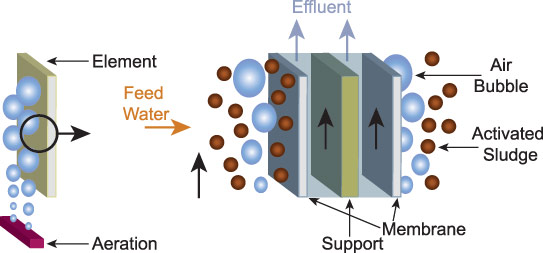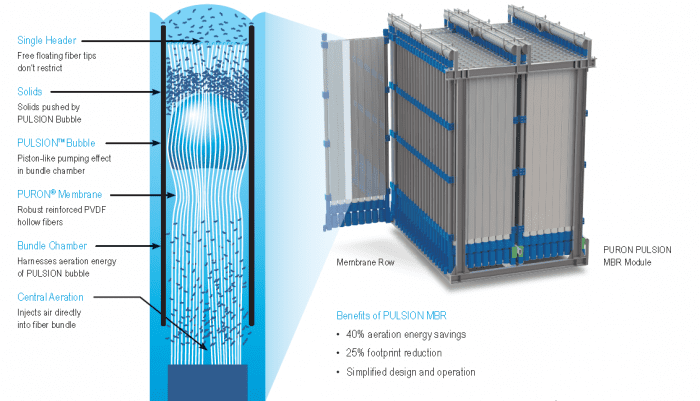Comprehending Membrane Bioreactors: The Future of Wastewater Therapy
Membrane bioreactors (MBRs) stand for a noteworthy advancement in the field of wastewater therapy, incorporating biological procedures with innovative membrane filtering to boost effluent quality. As worldwide water deficiency and stringent regulative structures come to be increasingly pressing concerns, MBR technology provides an efficient feedback through its ability to lessen impact and maximize source recovery.
What Are Membrane Bioreactors?

The core parts of MBR systems consist of a bioreactor where microbial task happens and a membrane layer system that filterings system the combined alcohol. This twin capability makes it possible for the synchronised destruction of raw material and solid-liquid splitting up in a solitary action. MBRs can operate in both submerged and external configurations, with submerged systems being more common due to their compact layout and functional performance.
The fostering of MBR innovation has acquired traction in various applications, varying from metropolitan wastewater therapy to commercial effluent administration. MBRs are particularly advantageous in circumstances where room is restricted or stringent effluent high quality requirements must be met. By keeping a high focus of microorganisms within the bioreactor, MBRs enhance the destruction of natural pollutants, thereby generating higher treatment performances compared to traditional approaches.
Secret Benefits of MBR Innovation
The integration of organic treatment with membrane layer filtration in MBR systems uses numerous benefits that establish it aside from traditional wastewater therapy methods. Among the key advantages is the enhanced effluent high quality. MBRs properly eliminate put on hold virus and solids, achieving greater degrees of purification that fulfill strict discharge requirements and promote water reuse applications.

An additional significant advantage is the minimized sludge manufacturing. MBR systems create less excess sludge, resulting in lower disposal expenses and a decline in ecological impact. The closed nature of the membrane system reduces the danger of smell exhausts and boosts overall process control.
Lastly, MBRs are versatile and adaptable, making them appropriate for different wastewater types, including industrial and local resources. The capability to incorporate with sophisticated therapy innovations additionally improves their efficiency, making MBRs an appealing solution for the future of wastewater management.
Challenges and Limitations of MBRs
While MBR modern technology offers countless benefits, it additionally encounters a number of difficulties and restrictions that can impact its widespread fostering. One substantial difficulty is the high funding and operational costs connected with MBR systems. The first financial investment for membrane materials this content and the essential framework can be considerable, making it less accessible for smaller sized industries or municipalities.
In addition, membrane fouling remains a critical concern that can reduce system performance and rise maintenance demands. Fouling takes place when solids, raw material, or bacteria build up on the membrane layer surface, leading to lowered permeability and requiring regular cleaning or substitute.
Another constraint includes the intricacy of the innovation. MBR systems require proficient personnel for procedure and maintenance, which can be an obstacle in regions with restricted technical experience. The disposal of spent membrane layers presents environmental problems, as the materials are commonly not biodegradable and can contribute to lose management difficulties.
Last But Not Least, while MBRs can effectively treat a large range of wastewater, they may not be appropriate for all applications, specifically those with high concentrations of fats, oils, and greases, requiring more study and development to attend to these constraints.
Applications of Membrane Layer Bioreactors
In various industries, membrane layer bioreactors (MBRs) have actually arised as a functional solution for wastewater treatment (Membrane Bioreactor). Their applications span local, commercial, and farming setups, showcasing their flexibility and performance in diverse environments. In community wastewater treatment plants, MBRs considerably improve effluent high quality, permitting water reuse and lowering the ecological influence of released wastewater
Industrially, MBRs are used in food and drink handling, fabric production, and pharmaceutical manufacturing, where they successfully deal with high-strength waste streams. Their ability to manage differing and get redirected here varying tons pollutant concentrations makes them specifically beneficial in these sectors. In addition, MBRs promote the elimination of virus, suspended solids, and raw material, adding to conformity with rigid discharge guidelines.
In agriculture, MBRs are increasingly used for dealing with farming overflow and livestock wastewater, making it possible for the recuperation of nutrients for fertilizer production. They also help in the treatment of greywater for irrigation, advertising sustainable water management techniques.
The convenience of MBRs is additional evidenced by their assimilation with various other innovations, such as anaerobic digestion and progressed oxidation processes, boosting general performance and source healing in wastewater therapy systems.
The Future of Wastewater Therapy
Developments in modern technology and a growing emphasis on sustainability are forming the future of wastewater treatment. Membrane layer bioreactors (MBRs) exemplify this change by integrating organic treatment procedures with membrane purification, leading to high-quality effluent ideal for reuse. The trend in the direction of circular economic situations is prompting centers to adopt MBRs for their capacity to recover sources, such as water and nutrients, from wastewater.
Innovations in membrane layer materials and setup are boosting the effectiveness and long life of MBR systems, decreasing functional costs and energy intake. Smart technology combination, consisting of real-time tracking and automated control systems, is more optimizing performance and making it possible for predictive maintenance, hence minimizing downtime.
Furthermore, social expectations and regulatory pressures are pressing markets and districts to adopt more sustainable methods. Membrane Bioreactor. The shift towards decentralized wastewater therapy services is getting grip, enabling localized treatment that decreases transportation expenses and power usage
Conclusion
Membrane bioreactors (MBRs) represent a transformative method to wastewater treatment, incorporating organic procedures with sophisticated membrane innovation. The benefits of MBRs, consisting of boosted effluent top quality, lowered spatial needs, and reduced sludge manufacturing, place them as a sensible solution amid growing urbanization and stricter ecological laws. Regardless of existing obstacles, the ongoing technology in membrane layer products and functional methods guarantees to reinforce the effectiveness and adoption of MBRs, ensuring their view website pivotal duty in the future of lasting wastewater monitoring.
Membrane layer bioreactors (MBRs) represent a noteworthy innovation in the area of wastewater therapy, integrating biological processes with innovative membrane layer filtering to enhance effluent quality.Membrane layer bioreactors (MBRs) integrate biological treatment procedures with membrane filtration to effectively deal with wastewater.The combination of biological therapy with membrane filtration in MBR systems supplies countless advantages that set it apart from typical wastewater treatment methods. Membrane layer bioreactors (MBRs) exemplify this change by incorporating biological therapy processes with membrane layer filtering, resulting in top quality effluent suitable for reuse.Membrane layer bioreactors (MBRs) represent a transformative strategy to wastewater treatment, incorporating biological procedures with sophisticated membrane innovation.